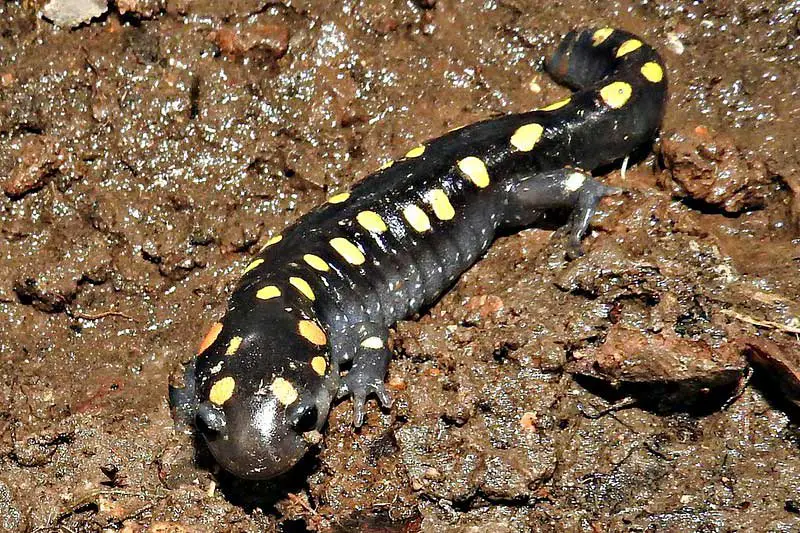When you first glance at them, salamanders look similar to lizards. However, salamanders are amphibians, not reptiles. They have smooth, moist skin with no scales or claws. Many of the salamanders in Salamanders are delicate, small, and brightly colored.
Pennsylvania is the 33rd largest state in North America with an area of 46,055 square miles. The state has has over 2500 lakes and the northwest corner also borders Lake Erie providing many moist habitats that are perfect for many salamanders. Most of the amphibians in Pennsylvania live in various permanent water bodies like these. However, some salamander species are only land-dwelling as adults but prefer moist conditions that the state provides.
Now, let’s explore the 22 species of salamanders found in the state of Pennsylvania (PA).
22 Salamanders in Pennsylvania
The 22 different species of salamanders in Pennsylvania are:
- Eastern Hellbender
- Northern Dusky Salamander
- Mountain Dusky Salamander
- Red-backed Salamander
- Ravine Salamander
- Northern Slimy Salamander
- Four-Toed Salamander
- Spring Salamander
- Midland Mud Salamander
- Northern Red Salamander
- Green Salamander
- Northern Two-Lined Salamander
- Longtail Salamander
- Spotted Salamander
- Blue-Spotted Salamander
- Jefferson Salamander
- Marbled Salamander
- Mudpuppy
- Eastern red-spotted newt
- Seal salamander
- Valley and ridge salamander
- Wehrle’s salamander
Keep reading to learn about each one..
1. Eastern Hellbender

Scientific name: Cryptobranchus alleganiensis
The Eastern Hellbender averages 11.5 to 24 inches in length but can grow up to 27 inches, making it the state’s largest salamander and one of the big 3 giant salamanders in the world. Despite their size, they are quite harmless and an endangered species. You can find them in swift-flowing water habitats in most of Pennsylvania, where they hide under large rocks during the day.
2. Northern Dusky Salamander
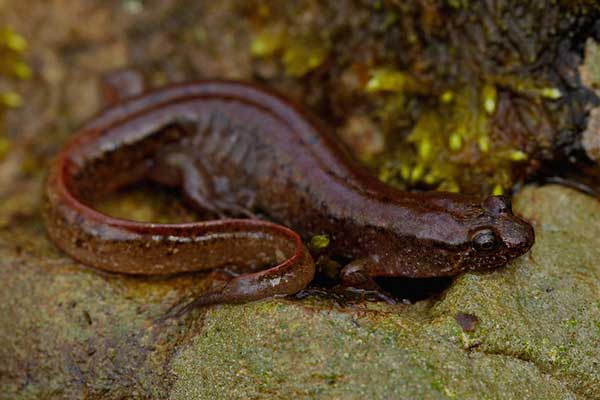
Scientific name: Desmognathus fuscus
The Northern Dusky salamander is a common species in Pennsylvania, distinguishable by the light line extending from the back of their eyes to the back of their mouth. These salamanders grow an average of 2.5 to 4.5 inches in length. They enjoy flowing water habitats throughout the state.
3. Allegheny Mountain Dusky Salamander
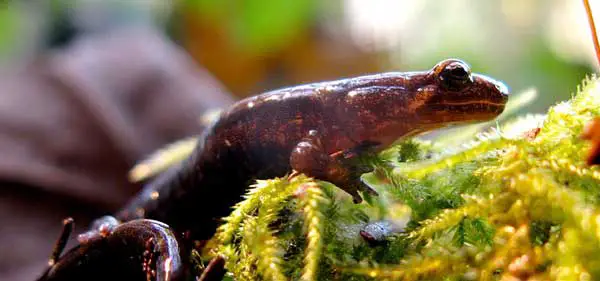
Scientific name: Desmognathus ochrophaeus
The Mountain Dusky Salamander can be found in much of Pennsylvania, though they don’t occur as much in the southeast areas of the state. They look similar to the Northern Dusky Salamander, except they have a more rounded tail and stripes down their backs. These salamanders grow around 2.75 to 4 inches in length.
4. Red-backed Salamander
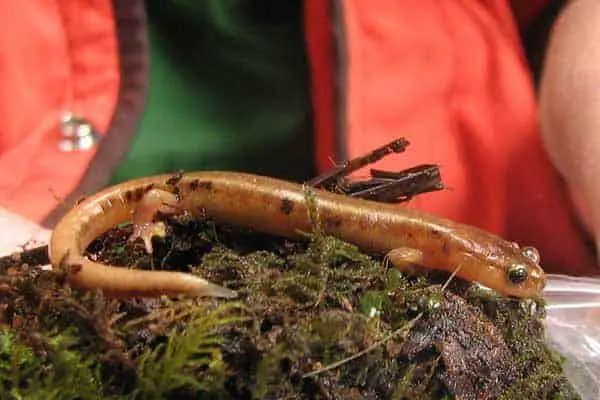
Scientific name: Plethodon cinereus
The red-backed salamander is terrestrial and even lays its eggs in clusters under moist rocks or logs on land. They grow around 2.25 to 3.5 inches in length and are commonly found throughout Pennsylvania. You can often see them during the early spring beneath logs and rocks, especially on floodplains.
5. Ravine Salamander

Scientific name: Plethodon electromorphus
As its name suggests, the Ravine salamander prefers the slopes of wooded ravines where it lives under logs and rocks. You can find this species in the extreme southwestern corner of Pennsylvania only. During midsummer, they burrow deep underground to seek moisture. These salamanders grow between 3 to 4.5 inches in length.
6. Northern Slimy Salamander
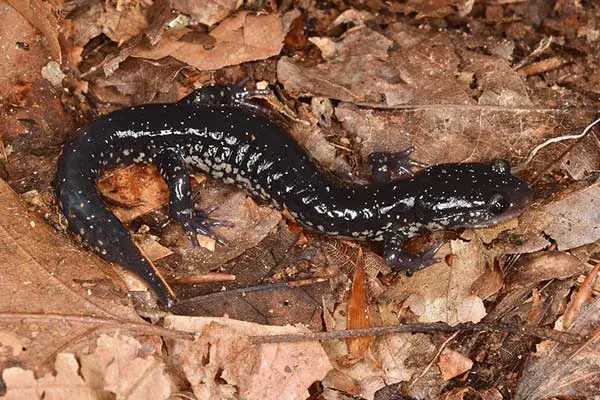
Scientific name: Plethodon glutinosus
The Northern Slimy salamander exists throughout Pennsylvania. They grow between 4.75 and 6.75 inches in length and have very slimy skin secretions that can be very hard to wash off if they dry on your hands. These land-dwelling salamanders prefer moist areas under rotting stumps and logs.
7. Four-Toed Salamander
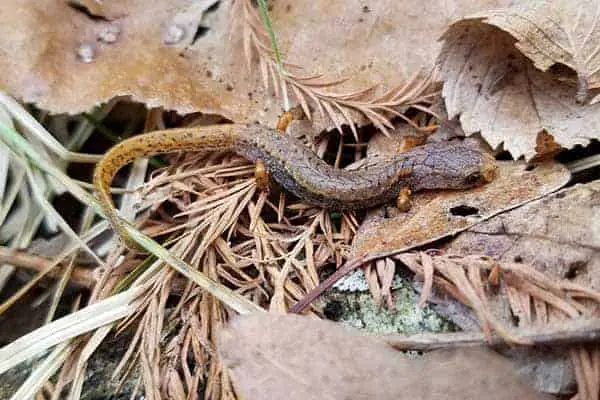
Scientific name: Hemidactylium scutatum
The tiny Four-toed salamander grows around 2 to 3 inches in length and is one of the two species with four toes instead of five. They also have a distinctive white belly with black speckles. You can find them scattered throughout Pennsylvania, close to swamps and boggy woodland ponds.
8. Spring Salamander

Scientific name: Gyrinophulus porphyriticus
Spring salamanders occur in most of the state of Pennsylvania, except for the southeastern corner of the state where they are not common. They are between 4 to 7 inches in length and have two different races: the Kentucky Spring salamander and Northern Spring salamander. As their name suggests, they prefer flowing water habitats such as springs and clear woodland brooks.
9. Midland Mud Salamander
Scientific name: Pseudotriton montanus diastictus
The Midland Mud salamander prefers muddy habitats near slow woodland streams, seeps, and springs. They aren’t common in Pennsylvania and only occur in a few extreme southern parts of the state. They have red bodies, brown irises, and a few black spots on their body. These salamanders grow between 3.5 to 6 inches in length.
10. Northern Red Salamander
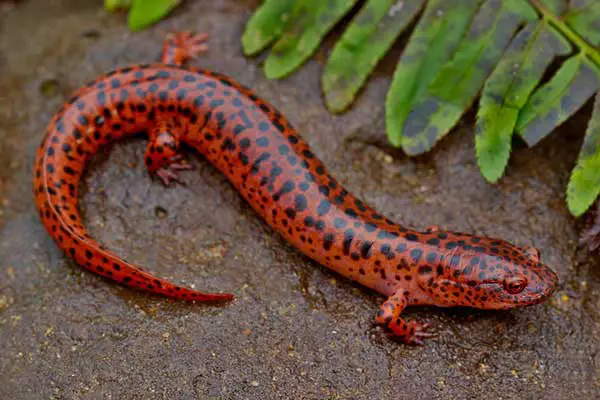
Scientific name: Pseudotrition ruber ruber
The adult Northern Red salamander is bright red with multiple scattered black spots. They are different from other red-colored salamanders because of their stout bodies and yellow-gold irises. These salamanders live in flowing water habitats throughout Pennsylvania.
11. Green Salamander

Scientific name: Aneides aeneus
You can only find this rare salamander species that’s listed as threatened in an area of Fayette County in Southwest Pennsylvania. The Green salamander grows between 3 to 5 inches in size and has a green and black pattern on its body. Their flattened head and body also make it easy for them to move in the moist cracks of sandstone and limestone cliffs they inhabit.
12. Northern Two-Lined Salamander
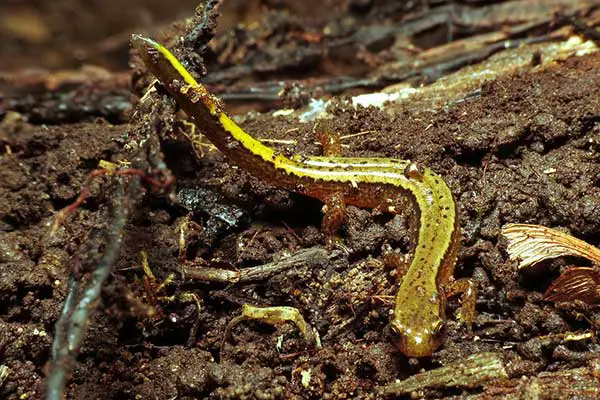
Scientific name: Eurycea bislineata
The Northern Two-lined salamander can be found in much of Pennsylvania in springs, seeps, and small rocky streams. The northern variety is common in the Great Lakes region and the northeastern U.S., while the southern two-lined salamander is common in the Southeast United States. They grow between 2.5 and 3.75 inches in length and have two dark lines on either side of their yellow or golden-brown body.
13. Long-tailed Salamander

Scientific name: Eurycea longicauda
As its name suggests, this salamander has a long tail over half the length of its body that grows up to 6.5 inches. They prefer shale banks and seep areas throughout the wooded and hilly regions throughout Pennsylvania.
14. Spotted Salamander

Scientific name: Ambystoma maculatum
The Spotted salamander prefers standing water habitats throughout the entire state. They are common to find and grow between 6 to 7.75 inches in length. You can identify these salamanders by their two rows of greenish-yellow or yellow spots along their backs.
15. Blue-Spotted Salamander
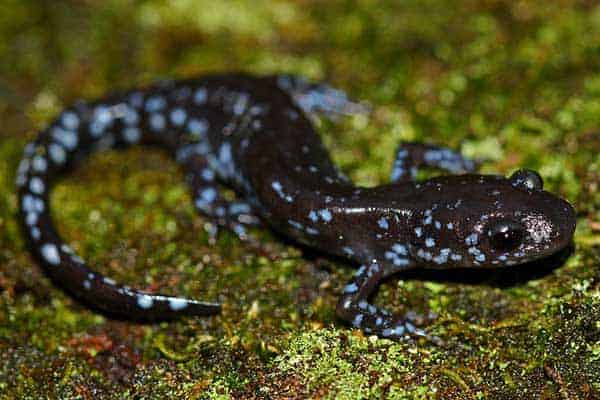
Scientific name: Ambystoma laterale
You can identify the Blue-Spotted salamander by the bluish-black body and blue specks, creating an appearance like old-fashioned enamelware. These salamanders grow between 4 and 6 inches in length and can only be found in a few areas of extreme eastern Pennsylvania. Due to their limited habitat and range in the state, they are considered endangered and protected. The blue-spotted salamander has been spotted in Northampton, Warren, and McKean County in Pennsylvania.
16. Jefferson Salamander
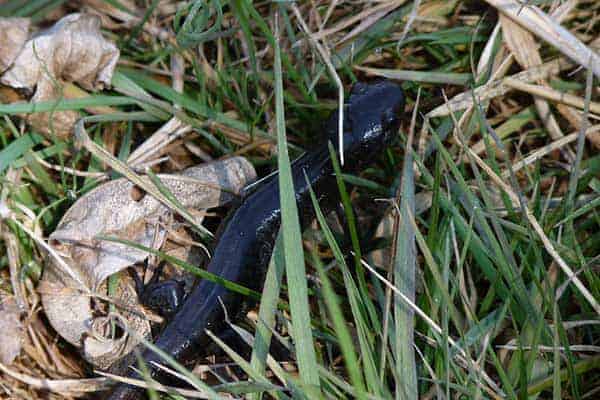
Scientific name: Ambystoma jeffersonianum
The Jefferson salamander was named after Thomas Jefferson. They have a wide range in Pennsylvania but they are elusive, and you only see them when they enter ponds for breeding in the early spring. They grow between 4.5 to 7 inches, have long toes, and small silver-blue specks on their body. These salamanders prefer standing water habitats and moist woodlands throughout the state, except for the northwestern area.
17. Marbled Salamander
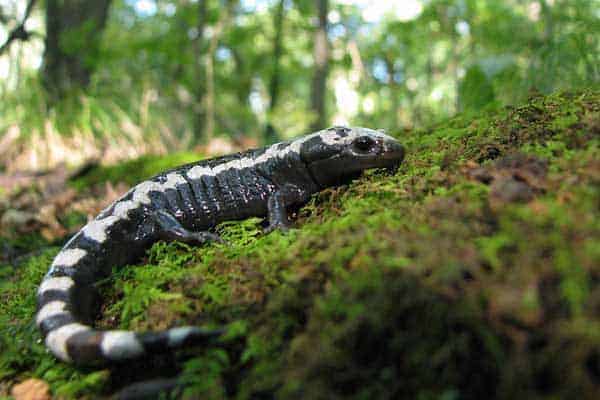
Scientific name: Ambystoma opacum
The Marbled salamander has distinctive marks on its body with bright white bands on black for males and grayish-white on black for females. They grow between 3.5 and 4.5 inches in length. Marbled salamanders occur throughout most of Pennsylvania, they’re less common in northern and northwestern areas of the state.
18. Mudpuppy
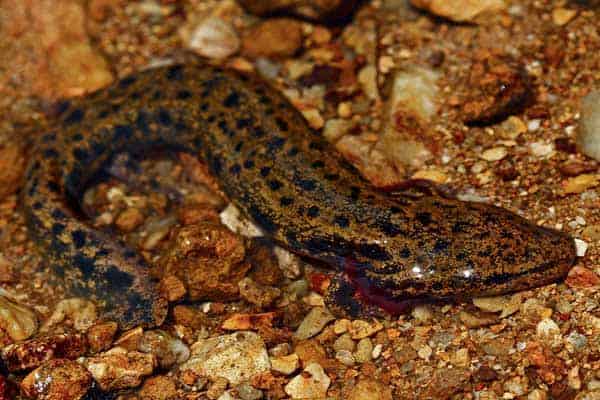
Scientific name: Necturus maculosus maculosus
Mudpuppies occur in the western third of Pennsylvania in large rivers and streams, including Lake Erie. They are nocturnal and feed on aquatic insects and crayfish. These large salamanders grow between 8 to 13 inches in length and have flattened, broad heads. Unlike most other salamanders, the Mudpuppy has only four toes on its front feet instead of five.
19. Eastern newt

Scientific name: Notophthalmus viridescens
The eastern newt is a very common salamander in the eastern half of the United States. The subspecies of the eastern newt found in Pennsylvania is the red-spotted newt, they are found throughout the state and neighboring states like Ohio.
Eastern newts live in deciduous and coniferous forests as well as bodies of water with muddy bottoms. They are between 2.5 and 5 inches in length as adults and feed on insects, fish, eggs and larvae, snails, slugs, and worms.
20. Seal salamander
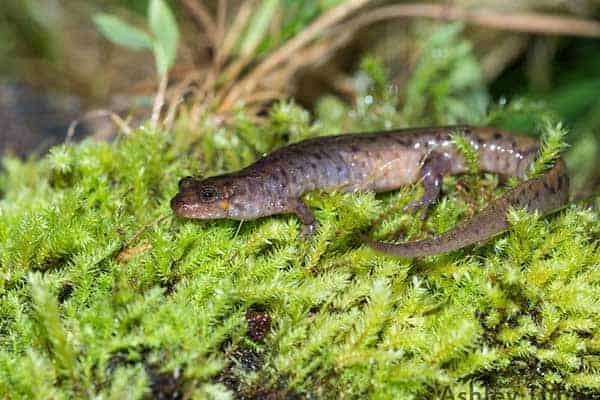
Scientific name: Desmognathus monticola
The seal salamander can be found from Southwestern Pennsylvania all the way to Southern Alabama. These stream salamanders are in a family of lungless salamanders call Plethodontidae. They breathe through their skin while living the majority of their lives on land in forests, though you’ll always find them near a stream or creek. They reach up to 5 inches in length as adults, and feed both terrestrial and aquatic invertebrates.
21. Valley and ridge salamander
Scientific name: Plethodon hoffmani
These Pennsylvania salamanders are primarily brownish-black with silver and white flecks all over their bodies. Valley and ridge salamanders are found in Central Pennsylvania in deciduous and mixed hardwood forests, usually near streams or other water sources. They are fairly small reaching between 3 and 5 inches as adults. This species mainly occurs in valley and ridge geography, hence the name. In Pennsylvania, they are known to occur in the Susquehanna River Valley.
22. Wehrle’s salamander
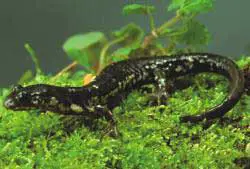
Scientific name: Plethodon wehrlei
The Wehrle’s salamander can be found in some areas of western Pennsylvania. They’re typically bluish-black with scattered light spots on their body. Wehrle’s salamanders stay hidden under logs and rocks during the day, and come out at night to look for food.
